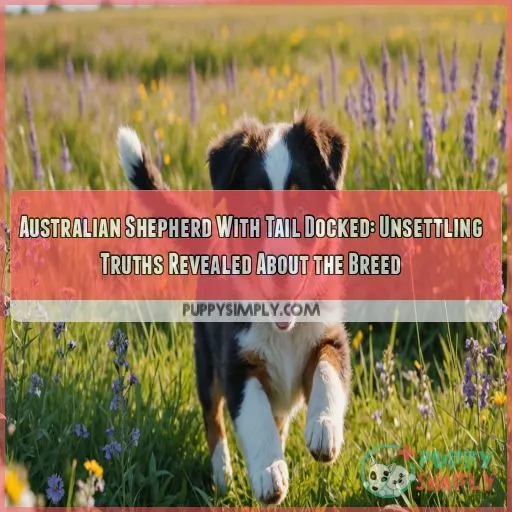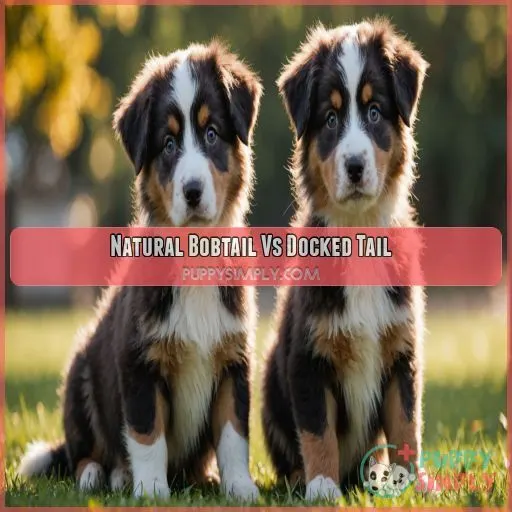This site is supported by our readers. We may earn a commission, at no cost to you, if you purchase through links.
 You’re considering an Australian Shepherd with a tail docked, but have you ever wondered why this practice started in the first place?
You’re considering an Australian Shepherd with a tail docked, but have you ever wondered why this practice started in the first place?
Historically, Tail Docking was done to prevent injury during herding.
Today, many countries have banned it for cosmetic purposes.
As an Aussie enthusiast, you should know that a docked tail can lead to chronic pain, nerve damage, and even behavioral changes.
So, what’s the best approach?
If you’re thinking of bringing an Aussie into your family, you’ll want to weigh the pros and cons of docking.
Let’s get started on this tail-wagging journey!
Table Of Contents
- Key Takeaways
- Australian Shepherd Tail History
- Natural Bobtail Vs Docked Tail
- Health Implications of Tail Docking
- Caring for an Australian Shepherd’s Tail
- Tail Traits and Behavior
- Responsible Breeding and Ownership
- Laws and Regulations Surrounding Docking
- Promoting Awareness and Education
- Making an Informed Decision
- The Future of Australian Shepherd Tails
- Frequently Asked Questions (FAQs)
- Should Australian Shepherds tails be docked?
- Do all Australian Shepherds have a white tipped tail?
- How do you tell the difference between a natural bobtail and a docked tail?
- Is tail docking cruel?
- Are Australian Shepherds born with tails or without tails naturally?
- How long should an Australian Shepherds docked tail be ideally?
- What percentage of Australian Shepherds are born with natural bobtails?
- Can Australian Shepherds be shown with full tails in competitions?
- Is tail docking of Australian Shepherds a painful procedure usually?
- Conclusion
Key Takeaways
- You’re probably wondering if an Australian Shepherd‘s tail should be docked, but here’s the thing: most Aussies aren’t born with that iconic bobtail, and docking can cause harm, so it’s worth reconsidering this practice.
- A docked tail can lead to chronic pain, nerve damage, and even behavioral changes in your Aussie, so it’s crucial to weigh the pros and cons before making a decision.
- If you do decide to bring home an Aussie, remember that their natural tail is a beautiful part of who they are, and it’s worth preserving – plus, only about 15% of Australian Shepherds are born with natural bobtails, making them all the more unique.
- As attitudes shift and more owners prioritize dog welfare, you’re part of a movement to rethink tail docking in Australian Shepherds – so take the time to consider the breed standard, your dog’s welfare, and the alternatives to docking before making a decision.
Australian Shepherd Tail History
As you explore the fascinating world of Australian Shepherds, you’ll discover that their tail history is a story of evolution, driven by the needs of ranchers and farmers who relied on these versatile dogs to help them with their daily tasks.
The Australian Shepherd’s tail has undergone significant changes, influenced by genetics, breeding practices, and human preferences.
From their origins in the western United States to the development of the breed standard, the Australian Shepherd’s tail has undergone significant changes.
Origins of the Breed
You’re probably wondering how the Australian Shepherd breed came to be.
Well, let’s take a trip back in time to the 19th and 20th centuries when Western ranching was in full swing.
Ranchers needed reliable working dogs with really good herding skills, and the Aussie was born.
Early uses on ranches and farms shaped the breed’s origins, deeply rooted in Western history.
Development of the Breed Standard
As the Australian Shepherd breed took shape, a breed standard was needed. In 1968, the Australian Shepherd Club of America (ASCA) published its first breed standard, which included a description of the breed’s natural bobtail. Here are key points about the Breed Standard development:
- The breed standard called for a natural bobtail or docked tail, with a maximum length of four inches.
- The ASCA emphasized the importance of the breed’s working ability and intelligence.
- The breed standard has evolved over time, with a growing emphasis on preserving the breed’s unique characteristics.
Evolution of Tail Characteristics
As the Australian Shepherd breed developed, its tail characteristics evolved too. You might wonder, what’s the big deal about their tails? Well, let’s break it down.
| Tail Characteristic | Description |
|---|---|
| Natural Bobtail | Short, stubby tail due to genetics |
| Docked Tail | Surgically shortened tail, often for aesthetic |
| Full Tail | Long, feathered tail, considered a deviation |
| Tail Length Variations | Range from 1-4 inches, impacting breed standard |
These tail variations profoundly impact the breed’s appearance and function.
Natural Bobtail Vs Docked Tail
You’re about to discover the fascinating world of Australian Shepherd tails, where the debate between natural bobtails and docked tails has sparked intense discussion among breeders and owners. As you explore this topic, you’ll learn about the genetics behind the natural bobtail, how to identify one, and the key differences between these unique tails and their docked counterparts .
Genetics of the Natural Bobtail
You’re probably wondering how Australian Shepherds get their signature natural bobtail. It’s all about genetics! The natural bobtail trait is the result of a genetic mutation that affects the development of the tail. Breeding strategies and genetic diversity play a significant role in the expression of this trait. Responsible breeding practices are key to preserving the breed’s unique characteristics.
Identifying a Natural Bobtail
So, you want to identify a natural bobtail on an Australian Shepherd? It’s actually quite simple.
A natural bobtail typically measures four inches or less in length. Look for a tail that’s proportionate to the dog’s body and has a defined structure.
Breed standard compliance is key here. Check for the distinctive characteristics that set this breed apart – you’ll be a pro in no time!
Differences Between Natural and Docked Tails
You now know how to identify a natural bobtail, but let’s get into the nitty-gritty of the differences between natural and docked tails.
Here are four key differences:
- Tail Length Variations: Natural bobtails can vary in length, while docked tails are typically shorter and more uniform.
- Breeding for Tails: Some breeders prioritize breeding for natural bobtails, while others focus on docked tails for cosmetic appeal.
- Pain Perception Differences: Research suggests that dogs with docked tails may have altered pain perception, potentially leading to chronic pain.
- Canine Expression Changes: A docked tail can affect a dog’s ability to express itself, potentially leading to changes in behavior and communication.
Health Implications of Tail Docking
As you consider the Australian Shepherd breed, you need to understand the health implications of tail docking, a practice that’s been a part of the breed’s history. You’ll want to weigh the potential risks and long-term effects of docking against the alternatives, and make an informed decision that prioritizes the welfare of your future furry friend.
Risks of Docking
Docking your Australian Shepherd’s tail comes with serious health risks. You’re exposing your furry friend to pain management issues, infection risks, and potential chronic conditions like nerve damage. Behavioral changes can also arise, impacting that special bond you share. And let’s not forget acute caudal myopathy, also known as limber tail, which can leave your poor pup in agony.
Long-term Effects of Docking
As an Aussie owner, you should know that docking can lead to long-term health implications.
These implications include chronic pain, sensitivity issues, and behavioral changes. Your dog may experience tail biting or chasing due to the lingering discomfort.
In some cases, docking can even increase the risk of spina bifida, a genetic mutation.
This is vital for your furry friend’s pain management and overall well-being, and it’s essential that you weigh the potential consequences for their health.
Alternatives to Docking
You’re considering alternatives to docking your Australian Shepherd’s tail. That’s a great step! You’re prioritizing your dog’s welfare and exploring humane options. Here are 4 alternatives worth exploring:
- Embracing the natural look: Leave your Aussie’s tail intact and celebrate its unique breed characteristics.
- Tail care methods: Regular grooming and maintenance can prevent health issues and promote a healthy, full-length tail.
- Non-surgical options: Explore pain management techniques to address any tail-related injuries or issues.
- Breed standard revision: Support a revised breed standard that promotes humane breeding practices and values the full-tailed exhibit.
Caring for an Australian Shepherd’s Tail
As you welcome an Australian Shepherd with a docked tail into your family, learning the ropes of tail care is vital for their comfort and happiness. By staying on top of grooming and maintenance, you can prevent health issues and quickly recognize any potential tail injuries, giving your furry friend the best possible life.
Grooming and Maintenance
You’ve got a furry friend at home, and their tail needs some TLC!
Brushing techniques are key for a healthy coat.
Nail care is super important to prevent scratching.
Don’t forget coat trimming and ear cleaning.
As seasons change, shedding management is a must.
Regular grooming helps prevent allergies, skin irritation, and hot spots, keeping your Aussie happy and healthy.
Preventing Health Issues
As you care for your Australian Shepherd‘s tail, remember that prevention is key. Regular grooming and hygiene practices can help prevent matting and skin issues. Consider genetic testing and health screenings to identify potential health considerations. By prioritizing your dog’s tail health, you’re helping to preserve their breed heritage and ensure their overall well-being and happiness.
Recognizing Tail Injuries
If you’re worried about your Australian Shepherd’s tail, you need to keep an eye out for signs of trouble. Here are three things to watch for:
- Swelling or redness: If the tail is swollen, red, or painful to the touch, it may be infected.
- Limping or favoring: If your Aussie is limping or favoring their tail, it could be a sign of a break or strain.
- Whining or licking: If your dog is whining or excessively licking their tail, it may be a sign of pain or discomfort.
Stay vigilant, and your Aussie will thank you!
Tail Traits and Behavior
When you get into the world of Australian Shepherds with docked tails, you’ll see how this breed’s tail traits and behavior are closely linked to their herding instincts and how they move. You’ll learn how their tail language and communication are key to how they interact with humans and other animals, and how tail docking can affect these natural behaviors.
Connection Between Tail and Herding Instinct
As you care for your Australian Shepherd’s tail, you may wonder how it affects their herding instinct. The connection is real. A tail helps them balance and communicate while herding. Here’s a breakdown:
| Tail Function | Herding Benefit | Canine Communication |
|---|---|---|
| Balance | Prevents accidents | Confidence |
| Expression | Conveys intent | Avoids misunderstandings |
| Signaling | Directs herd | Clarifies commands |
Your Aussie’s tail plays a big role in their herding behavior.
Impact of Tail on Balance and Movement
As you watch your Australian Shepherd run and play, you’ll notice how their tail affects their balance and movement. A longer tail can act as a counterbalance, helping them make sharp turns while herding or maneuvering through agility courses. Conversely, a docked tail may impact their movement style, requiring adjustments to their exercise and activity monitoring to prevent injuries.
Tail Language and Communication
As you get to know your Australian Shepherd, you’ll discover their tail is a key communication tool. A wagging tail signals excitement or friendliness, while a tucked tail may indicate fear or submission. By recognizing these tail expressions, you’ll better understand your dog’s emotions and needs. This breed characteristic is important for identifying their alertness and mood.
Responsible Breeding and Ownership
As you consider bringing an Australian Shepherd with a docked tail into your life, understanding responsible breeding and ownership practices that prioritize the breed’s integrity and welfare is key. By embracing ethical breeding methods and valuing genetic diversity, you’ll be getting a healthy and well-tempered companion, and also contributing to the preservation of this beloved breed’s unique characteristics .
Preserving the Breed’s Integrity
As a responsible breeder or owner, you play a vital role in preserving the Australian Shepherd’s integrity. By committing to selective breeding and adhering to the breed standard evolution, you’re ensuring the conservation of unique genetic traits. Remember, breeder accountability is key to tail ethics and responsible stewardship. Your choices shape the breed’s future – choose wisely!
Ethical Breeding Practices
You’re considering bringing an Australian Shepherd into your family, but want to guarantee you’re supporting responsible breeding practices. Here are three things to check for:
- Breeding for temperament: A reputable breeder prioritizes temperament, guaranteeing a well-adjusted pup.
- Breeder accountability: Check for breeders registered with organizations like ASCA or AKC, adhering to transparency standards.
- Genetic testing: A responsible breeder conducts genetic testing to avoid inbreeding risks and lethal genes.
Importance of Genetic Diversity
You’re considering bringing an Australian Shepherd into your family, and you want to make sure you’re supporting responsible breeding practices. One important aspect is genetic diversity. Think of it like a recipe: too much repetition can lead to a bland dish. Here’s a snapshot of why genetic diversity matters:
| Breeding Strategies | Risks of Inbreeding |
|---|---|
| NBT to NBT breeding | Increased birth defects |
| Merle gene emphasis | Health issues and vision loss |
| Pedigree analysis | Reduced gene pool conservation |
Laws and Regulations Surrounding Docking
As you explore Australian Shepherds, understanding the laws and regulations surrounding tail docking, a practice that’s been a part of the breed’s history, is vital. From international laws to country-specific regulations, getting a grip on these rules will help you make informed decisions about your Aussie’s tail and stay on the right side of the law .
International Laws and Regulations
As you explore the realm of Australian Shepherds, you’ll discover that many countries have banned tail docking altogether. Global docking bans are in place in Europe, Australia, and Brazil, with animal welfare acts prioritizing canine protection. The ASCA, AKC, and USASA are also reevaluating their breed standards, promoting tail legislation reform and a more natural approach to the breed.
Country-Specific Laws and Regulations
As you explore country-specific laws and regulations surrounding docking, you’ll find that the US has varying rules. The ASCA, AKC, and USASA have breed standards that allow docking, but some states, like California and New York, have banned it. Globally, many countries have enacted docking bans, with the Western US being a notable exception – for now.
Changing Perceptions and Laws
You’re part of a movement to change perceptions and laws surrounding tail docking. Public awareness campaigns and lawsuits against docking are gaining momentum. Breed standard reforms are underway, with organizations like the ASCA, AKC, and USASA reevaluating their stance. The global anti-docking movement is driving change, pushing for animal welfare laws that prioritize a dog’s well-being over aesthetics.
Promoting Awareness and Education
You’re now part of a movement to promote awareness and education about the Australian Shepherd breed, specifically those with docked tails. By sharing your newfound knowledge with fellow Aussie enthusiasts, breeders, and owners, you’ll help spread the word about the importance of responsible breeding practices and the potential risks associated with tail docking.
Utilizing Social Media and Online Communities
As you join the conversation about Australian Shepherds and tail docking, remember that social media and online communities can be powerful tools for promoting awareness and education. By sharing your thoughts and experiences, you can help create a ripple effect that inspires change.
Here are three ways to make an impact:
- Join online forums: Participate in discussions on platforms like Facebook groups, Reddit forums, and breed-specific communities.
- Share personal stories: Post about your own experiences with Australian Shepherds and the importance of promoting canine welfare.
- Use hashtags: Utilize relevant hashtags like #AustralianShepherd, #TailDocking, and #CanineWelfare to increase the visibility of your posts.
Collaborating With Breeders and Owners
As you continue to spread awareness about the importance of natural tails in Australian Shepherds, consider collaborating with breeders and owners. Join breeder support networks, participate in owner education programs, and engage in community outreach initiatives. By working together, you can promote a uniform understanding of the breed’s characteristics and shape the future of the breed.
Making an Informed Decision
As you think about bringing an Australian Shepherd into your family, you’re faced with a big decision: should you get a dog with a docked tail or one with its natural tail intact?
You’ll need to weigh the pros and cons of docking, consider the breed standard, and put the dog’s welfare first.
Pros and Cons of Docking
As you weigh the pros and cons of docking, consider the potential pain and long-term effects on your Aussie’s well-being. While some argue it enhances appearance, others prioritize function and ethics. Legality also plays a role, as many countries ban docking. Instead, focus on providing ample exercise, mental stimulation, and happiness through dog sports and training.
Considering the Breed Standard
When you’re thinking about docking an Australian Shepherd’s tail, you need to keep the breed standard in mind. The standard calls for a natural bobtail or a docked tail, but the docked tail can’t be longer than four inches. Here are a few things to remember:
- Natural bobtails are the best: The breed standard prefers natural bobtails over docked tails.
- Tail length matters: A docked tail shouldn’t be longer than four inches.
- Type is more important than tail: While the tail is a big part of the breed, it’s not the only thing that makes a dog an Australian Shepherd.
- It’s not just for show dogs: Remember, the breed standard isn’t just for dogs that compete in shows, it’s for all Australian Shepherds.
Prioritizing the Dog’s Welfare
Now that you’ve considered the breed standard, it’s time to prioritize your Australian Shepherd’s welfare.
Ask yourself, "What’s best for my dog?"
Tail health is really important, so think about pain management and preventing tail injuries.
Explore training methods that focus on positive reinforcement.
Invest in a fly dog collar, flirt pole, or puzzle toys for mental stimulation.
Your dog’s happiness is worth it!
The Future of Australian Shepherd Tails
As you consider the future of Australian Shepherd tails, you’re likely wondering what’s next for this beloved breed. With shifting perceptions and attitudes, the Australian Shepherd community is embracing the natural look and working to preserve the breed’s unique characteristics.
Shifting Perceptions and Attitudes
You’re part of the movement to rethink tail docking in Australian Shepherds. As attitudes shift, more owners and breeders prioritize dog welfare over traditional standards. Here are key takeaways:
- Tail docking ethics are under scrutiny worldwide.
- The Aussie’s natural tail beauty is gaining recognition.
- Breed standard evolution prioritizes health and well-being.
- Alternatives to docking are becoming more popular.
Embracing the Natural Look
As you consider the future of Australian Shepherd tails, it’s time to embrace the natural look. With only 15% of Aussies born with a natural bobtail, many owners are now opting to keep their dog’s tail intact. By doing so, you’re also prioritizing their welfare and promoting a more authentic, unique breed aesthetic.
Preserving the Breed’s Unique Characteristics
By embracing the natural look, you’re also preserving the breed’s unique characteristics.
You’re contributing to the genetic preservation of this iconic feature by valuing the natural bobtail.
Responsible breeding ethics safeguard that tail variations are protected, maintaining the breed’s identity.
Your Aussie’s tail is an integral part of its charm – let’s keep it that way!
Frequently Asked Questions (FAQs)
Should Australian Shepherds tails be docked?
You want to know if Australian Shepherds’ tails should be docked? Ironically, most Aussies aren’t born with the iconic bobtail. Docking can cause harm, and many experts and countries condemn it, so it’s worth reconsidering this practice.
Do all Australian Shepherds have a white tipped tail?
No, not all Australian Shepherds have a white-tipped tail. In fact, the breed standard focuses more on the tail’s length and natural bobtail trait rather than its color or tip pattern, so you’ll see some variation.
How do you tell the difference between a natural bobtail and a docked tail?
You can tell the difference between a natural bobtail and a docked tail by looking for a smooth, rounded tip on a natural bobtail, whereas a docked tail may appear more blunt or scarred.
Is tail docking cruel?
Cutting to the chase, tail docking can be a real pain – literally. Research suggests it may lead to chronic pain, heightened sensitivity, and a decreased quality of life for dogs, making it a cruel practice in many eyes.
Are Australian Shepherds born with tails or without tails naturally?
You’re wondering if Australian Shepherds are born with tails or without them naturally. Well, here’s the scoop: they can be born with either a natural bobtail or a full tail .
How long should an Australian Shepherds docked tail be ideally?
Think of your Aussie’s tail as a perfectly crafted puzzle piece – it should fit snugly into their overall look. Ideally, a docked tail should be no longer than four inches, blending seamlessly into their natural silhouette.
What percentage of Australian Shepherds are born with natural bobtails?
You’re curious about those adorable Aussie tails! Only about 15% of Australian Shepherds are born with natural bobtails, which is a unique characteristic of the breed. The rest often have their tails docked at birth.
Can Australian Shepherds be shown with full tails in competitions?
You’re wondering if Australian Shepherds can rock their full tails in competitions? Honestly, it’s highly unlikely! Judges penalize dogs with full tails, as the breed standard calls for a natural bobtail or docked tail.
Is tail docking of Australian Shepherds a painful procedure usually?
You’re wondering if tail docking is painful for dogs. Honestly, yes, it usually is. Docking involves surgically removing a portion of the tail, which can cause discomfort, pain, and potentially lead to chronic issues.
Conclusion
Brace yourself for a shocking truth: an Australian Shepherd with a tail docked may be paying a lifelong price for a centuries-old practice.
You’ve now learned the history, risks, and implications of tail docking.
As you weigh the pros and cons, prioritize the dog’s welfare and consider the breed standard.
If you do decide to bring home an Aussie, remember: their natural tail is a beautiful part of who they are and it’s worth preserving.
















